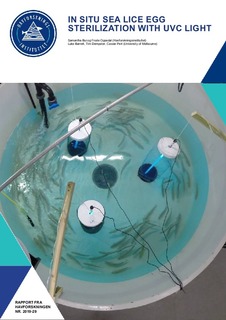| dc.description.abstract | Sea-cage salmon farming creates ideal conditions for population growth of the salmon louse Lepeophtheirus salmonis, potentially leading to poor welfare and mortality in farmed salmon and nearby wild salmonids. Frequent delousing treatments are necessary, but current treatments have drawbacks in terms of financial cost, stress to stock, and/or environmental impacts. We tested whether 254 nm ultraviolet-C light (UVC) could function as a new treatment to reduce production of infective copepodids in infested sea-cages. In Experiment 1, we removed mature egg strings from female lice and exposed the egg strings to precise doses of UVC light. A total dose of 0.008 J cm-2 reduced copepodid production by 5 %, while a 95 % reduction occurred at 0.09 J cm-2. In Experiment 2, we exposed salmon with attached adult lice to UVC light while they swam freely in tanks over a 6 day period, achieving a dose of ~0.1 J cm-2. The treatment resulted in a 99 % reduction in copepodid production relative to control groups. However, UVC negatively impacted fish welfare, causing higher rates of cataracts and skin irritation. In Experiment 3, we tested the sensitivity of fish (without lice) to increasing doses of UVC light, and found that minor skin injuries occurred at >60 % effective doses, while cataracts began to develop at very low doses. We conclude that UVC should only be used with caution, either for treatment of waste water to prevent louse eggs and larvae entering the environment (e.g. after delousing), or for short periods of time in-cage to suppress lice reproduction until fish are harvested. | nb_NO |
